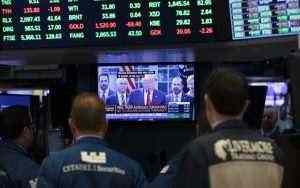

It also allows traders to hedge risk in the Stock market as Commodity prices generally move against it. So, if a particular Stock starts to fall, you can purchase more of the Commodity related to that Stock to potentially make up for your losses. There are private funds that invest in commodities but unlike mutual funds they are not publicly traded, so you must be approved to buy into them. Commodity pools and managed futures funds can use more complex trading strategies and offer the potential for higher returns than ETFs and other funds, although management fees are typically higher as a result.

If the market trades above well-defined resistance levels , heavy short covering will result in the market trading substantially higher. Conversely, if the price of an instrument breaks through well-defined support , liquidation of long positions will result in a sharp move lower. It is important for traders to identify when a commodity is reaching oversold territory as it suggests the commodity is undervalued and the price is set to rebound. Below are three of the most well-known commodity trading strategies any beginning trader might want to use. There are specific seasonal patterns that traders can watch for, and take advantage of, in commodity trading. More recently, seasonal trading software that basically incorporates such data has been created and is available for traders to use.
The Falling and Rising Wedges pattern help identify market reversal signals and accurate market entry and exit points. Shooting Star Candlestick PatternThe Shooting Star Candlestick Pattern can identify bearish market reversals and provide traders with ideal price levels to short or exit the trade. How to Use The Hanging Man Candlestick Pattern For Forex TradingThe Hanging Man Candlestick pattern provides downtrend reversal signals, which helps traders place sell or short orders to profit off falling markets. How to Use The Chaikin Money Flow IndicatorThe Chaikin Money Flow indicator provides future market direction by analysing the strength of the market trend and underlying buying or selling pressures. Whether you have a positive or negative view of the commodity price forecast, you can speculate on upward or downward future price movements. They may offer instant access to a diversified range of assets, which could take a longer time to build for yourself.
How to trade commodities?
After experiencing a multi-year bull market that drove oil prices over $100 a barrel, from 2014 onward, oil prices entered a sustained downtrend carrying the price back below $40 a barrel. Plus500SG Pte Ltd holds a capital markets services license from the Monetary Authority of Singapore for dealing in capital markets products (License No. CMS100648). Sign up for a demo account to hone your strategies in a risk-free environment.
Contracts for difference are leveraged products, meaning your potential profits can be magnified, but if the market goes against your position, so too are your losses. There are crucial differences between buying commodities and trading commodity CFDs. Due to overnight charges, necessary for position maintenance, CFDs are not typically used as long-term investments. On the crude oil market, tankers are used as floating storage when there is oversupply as traders wait for prices to rise. Trading commodities has become a popular means of inflation hedging and portfolio diversification. For many traders and investors, commodity trading is a preferred way to protect funds and reduce the overall risk for their portfolios.
Breakout strategies can be used when range trading with specified support and resistance levels, but they are not limited to just support and resistance level ranges. Identifying a breakout could help a trader profit from a substantial price move higher or lower. There is a multitude of commodity trading strategies, some that have been through rigorous testing and others that have been developed by individual traders over time. For commodity trading beginners, it is wise to research the market, understand basic trading products, and test out some of the most basic strategies before risking any hard-earned capital. If nothing else, proper awareness of seasonal tendencies in various commodity markets can at least help you avoid suffering huge losses. For example, only the bravest of traders ever holds a large short sell position in orange juice futures heading into winter, when just one overnight freeze can send orange juice futures prices suddenly soaring.
Traders holding wheat in the Commodities market can hold larger positions as the spring season approaches as it is expected to rise due to a surge in demand. Commodity prices are driven by supply and demand, which can be affected by economic activity, weather conditions, transportation and storage factors, geopolitical events and the value of the US dollar. Moreover, commodities trading through CFDs is often commission-free, with brokers making a profit from the spread and traders trying to profit from the overall change in price. A strategy focused on price action tracks the historical price movement of a commodity to predict how it could trade in the future. Commodity markets tend to be highly liquid, giving traders the chance to respond quickly to price volatility.

Any projections, estimates, forecasts, targets, prospects, and/or opinions expressed in these materials are subject to change without notice and may differ or be contrary to opinions expressed by others. Commodity futures trading may also offer lower commissions and trading costs, although with all the discount stock brokerages that exist now, that’s not as much an issue as it was 20 years ago. Plus500CY is the issuer and seller of the financial products described or available on this website. Trends work in commodities just like they do in other markets, arising when a metal is constantly reaching higher highs or falling to lower lows. The Doji Candlestick is a pattern used in technical analyses of trend reversals in a market.
However, ETFs incur management fees and, depending on their composition, may not provide the same returns as the asset it is supposed to track. When trading commodity CFDs you do not own the underlying asset, but only speculate on its price fluctuations. Therefore, trading CFDs does not involve paying extra fees for storage, which is the case with physical commodity delivery. Using CFDs to trade commodities will allow you to go long or short without having to deal with conventional commodities exchanges, such as CME, ICE or NYMEX. Commodities are most commonly traded on futures exchanges, allowing traders to speculate on future prices. If mines have to reduce their output, crops fail or oil producers decide to pump less, supply will decrease and prices will rise.
Range traders buy when prices are close to the support level at the bottom of a range and sell when prices approach resistance at the top of a range. A range trading strategy can be very successful, but it also comes with some caveats. It is possible that markets may remain in overbought or oversold territory for long periods of time making it difficult to determine good timing for entry or exit. When using range trading, there is always the risk that a commodity’s price could move beyond an expected support or resistance level.
Conversely good weather can yield bumper crops, resulting in an oversupply of agricultural commodities. The emergence of China and India as major engines of growth has increased their demand for commodities. But when a country enters a recession, economic activity contracts and demand for commodities falls. Most commodities markets are denominated in US dollars, so the value of the US currency has an impact on prices.
The Types of Commodity Trading Strategies Beginners Need to Know
Commodities trading in the past was dominated by multinational conglomerates purchasing raw materials for production as well as major banks and trading houses. But with the advent of online trading, private traders gained access to global commodities markets with relatively modest amounts of capital. Breakout trading, or buying just before a price shoots up and selling just before it drops dramatically, is best for markets with strong trends. Trading breakouts and fakeoutsBreakout and fakeout trading enable traders to take positions in rising and falling markets.
Speculating on a price with derivatives may be a preferred way to trade a commodity for retail investors, as you hardly want to take physical delivery. But if you do want to own a physical asset, like gold bullion or an oil barrel, you can buy it from a dealer and have it stored securely. Demand for some commodities is seasonal, with energy demand rising during the winter and falling during the summer. Commodities exchanges were set up in various physical locations around the world to facilitate trade, and the major producing and trading nationals still have their own exchanges.
Special characteristics of the commodities market
Once you decide on a trading strategy, you can test it on Plus500’s Free Demo Account to see if it holds out under simulation. In addition, you can refer to news outlets to get a gist of the market’s condition. To do so, you can also read Plus500’s up-to-date free News and Market Insights articles. A commodity’s price only fluctuates dramatically when its global demand and supply increases or decreases. A range trading strategy identifies the support and resistance levels that the price establishes, typically using technical analysis indicators like Bollinger Bands or other charting tools.
Commodity trading is the selling and buying of commodities traded worldwide. The most common Commodities for day traders are gold, oil, natural gas, and copper. While Commodities can be traded in their physical form, they are more popularly traded as Stocks, Futures, Options, ETFs, and CFDs. CFDs allow you to speculate on the price of commodities without having to take physical delivery or worry about storage costs for assets such as gold or silver bullion. Unlike futures contracts, CFDs do not have a specified expiry date, giving you flexibility as to when you close your position.
What are Pivot Points in ForexPivot Points help traders identify market reversals. With Pivot Points, traders can predict the support and resistance levels of a currency pair to make entry and exit decisions. A trader using a breakout strategy will seek to gain from buying just before a commodity price moves substantially higher or selling just before a price moves substantially lower. Position trading allows you to hold a trade for a long time, like months or even years, to benefit from long-term price movements. Position traders ignore all short-term price movements and only rely on fundamental aspects of the market and long-term trends. Breakout trading strategies can be used along with range trading when a price moves below support or above resistance, but they are not limited to those levels, as breakouts can happen at any time.
It will often be built around Bollinger Bands or some other channel charting that graphs support and resistance levels. A range trading strategy involves buying at the support level when prices are at the bottom of a range and selling at the resistance level when prices are at the top of a range. The fine-tuning of the trading strategy yielded an impressive improvement in profitability. Traders look to profit from a commodity breaking out of its recent trading range, buying before the price moves higher or selling before it drops lower.
What is the most traded commodity in the world?
A market cannot continue its trend without making new highs or new lows. It does not matter whether a trend is up or down, as the trader is buying new highs and selling at new lows. One critical caution for this strategy is that it performs poorly when markets are not able to establish strong, short-term trends. Alternatively, prices fall to the bottom of a range when traders are selling and supply is increasing. Overselling or oversold territory can be important to understand when watching the bottom range as these terms mean the market price of a commodity is below its estimated value with a rebound likely to occur.
What are commodities?
For example, you could invest in the stock of an oil refiner or copper miner, as the share price may respond to movements in the underlying commodity price. This could also reduce your risk exposure, as a company that is well run may still generate profits even when commodity prices fall. Commodity options are derivatives based on futures contracts for the underlying asset. Options contracts give the holder the right to buy or sell the underlying commodity at a specified price on a set date in the future.